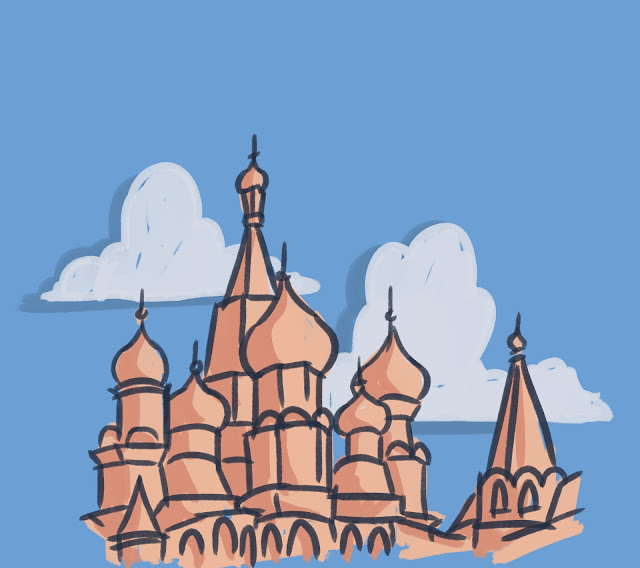Floating City
Above are some of my early concept sketches. I was aiming to get a general sense of a colour scheme and backdrop for the overall setting.
 |
| Moscow Skyline - Getty Images 2018; https://www.gettyimages.co.uk/detail/photo/moscow-skyline-aerial-view-royalty-free-image/175380213 |
Rebecca suggested that we blend in the brutalist style architecture that can be seen in parts of Moscow also. Buildings in this style are often large, concrete and rough to look at. If we wanted to demonstrate an accurate representation of the entirety of the city , we would need to be inclusive of all styles - even this one. Hailing from the Soviet era of the 1900s, we all liked how this would add an interesting and unusual aesthetic to our finished piece.
 |
| An example of Moscow's brutalist style. |
After some time deciding which buildings would best represent the Moscow skyline, we began splitting them up between the group. I took the Bolshoi Theatre and the Luzhniki Stadium.
Thematically, we also wanted to incorporate a toy-like concept into the animation. We looked at old Russian fairytales and bedtime stories. I thought that the "Welcome to Duloc" scene in Shrek (2001) would be a good example to reference this animated style. It's quirky and fun with jittery toy-like spinning and puppeteering movement. Watch it here
I set out modeling the theatre first as it seemed to be more complex architecturally. I used a front, plan and elevation blueprint as a reference when modeling to keep an accurate, true-to-scale model. This proved to be very useful with the dimensions. Once finished with all the detailing, I textured the model using Arnold shaders. I played around with bump mapping on the roof to create the illusion of tiling.
 |
| PROGRESS |
Then, I moved onto the stadium. This was a much more modern looking building so I wanted to keep the model looking clean. I worked on getting it to be symmetrical and round. In order to simulate a metal construction, I applied a chrome shader as a secondary color to the outer rims and columns surrounding the structure. I then modeled a simple football pitch inside the stadium along with a bump-mapped seating area.
Once we had all of our models complete we set out assembling them into one single scene. Using the Matryoshka doll concept that Kinga suggested, we began the animation with the doll opening to reveal the city inside. Each building would spring up from the ground like a toy one by one. Meanwhile, the camera would float around each one in the sky showcasing the model, while short facts would appear on screen alongside it. We ended up following this method successfully and I was pleased with our finished result.
A link to the finished animation.
We ended up using Tchaikovsky's "Dance of the Sugar-Plum Fairy" - I felt that this was fitting as it kept the Russian theme going, (as well as being royalty free). It worked out well with the timing and pacing of the animation as we could work to the rhythm of the song. Jacob also added a nice wind effect on top to give the audience a feeling of moving through the sky.
Overall, we received positive feedback from Mike and Alec during our final presentation. They enjoyed our style and models, and liked our choice of music. They did, however, suggest that we could exaggerate the toy theme even more with more Russian dolls.
















Comments
Post a Comment